Myron G. Best. Igneous and metamorphic 2003 Blackwell Science
Подождите немного. Документ загружается.


between initial and final conditions, internally buffered
reactions may not yield much change in modal com-
position of a rock.
Infiltration Metamorphism in Open Systems. Suppose
the rock is a highly permeable, open system and invas-
ive, perfectly mobile fluids from an external source
can penetrate along fractures and/or grain boundaries.
The infiltrating fluid significantly dilutes or even flushes
away that created by any local reaction; the mass of the
mobile fluid can be greater than that of the reacting
solid phases, the fluid/rock ratio is relatively high. Cal-
culations based on the reaction progress variable indic-
ate time-integrated fluid/rock ratios over the entire
course of the reaction are commonly 1 to 4 and locally
greater (Spear, 1993, p. 680). It has been argued by
some petrologists that the typical Barrovian metamor-
phism of carbonate-bearing metasedimentary rocks
requires significant infiltration of aqueous fluids, as
otherwise very high temperatures are needed. Systems
involving infiltration metamorphism in permeable
rocks include “flooding” of a local decarbonating sys-
tem by water liberated from nearby pelitic rocks experi-
encing dehydration reactions or by aqueous solutions
expelled from adjacent magmatic intrusions. The con-
tact metamorphic aureole is a particularly favorable
environment for infiltration metamorphism because of
the heat source that can drive advective flow. Two sce-
narios can be considered, again using the same isobaric
diopside-producing reaction as in Figure 16.19a.
In one case (I in Figure 16.19b), as before, a rock
composed of tremolite calcite quartz is heated
above 400°C but is simultaneously flooded by a mobile
fluid from a uniform external source whose composi-
tion is X 0.5. At T 525°C (or above as required
by necessary overstepping), diopside begins to be pro-
duced from the reactant phases, while the fluid com-
position remains the same. Under these conditions the
perfectly mobile fluids CO
2
and H
2
O are not counted
as components and consequently not counted as phases
either. Hence, the isobaric system is invariant because
it consists of three components (CaO, MgO, and
SiO
2
), four (solid) phases, and with T still an indepen-
dent variable, F 1 C 1 3 4 0. Any
additional heat input into the invariant system is con-
sumed by the endothermic devolatilization reaction
while T remains fixed at 525°C; more diopside is pro-
duced until one of the reactant phases is consumed.
Once this happens, the heating system can continue to
get hotter, leaving its invariant state on the reaction line
and rising along a vertical trajectory. This open-system
process involving a fixed fluid composition is basically
a discontinuous reaction that occurs at some specific T.
In the second scenario (II in Figure 16.19b), sup-
pose a rock at 500°C composed of tremolite calcite
quartz is suddenly invaded by essentially pure water
of the same T, perhaps by hydraulic fracturing in a
contact aureole or by pervasive advective flow along
permeable relict bedding planes. As the ambient fluid,
with a composition X 0.5, mixes with the greater
amount of infiltrating aqueous fluid, the rock system
follows a horizontal trajectory in Figure 16.19b that
eventually intersects the univariant curve where the
fluid is about X 0.3, producing diopside. In this
isobaric–isothermal situation, the changing composition
of the fluid drives the devolatilization reaction. As more
aqueous fluid invades the rock the composition of the
CO
2
CO
2
CO
2
Metamorphic Mineral Reactions and Equilibria
497
V 0.105 moles 44 cm
3
/mole
4.62 cm
3
per 100 cm
3
of rock
V 0.015 moles 23 cm
3
/mole
0.345 cm
3
per 100 cm
3
of rock
The remainder of the volumetric modal changes are
found in Problem 16.8. The changes in modal pro-
portions of solid phases are so small as to be barely
noticeable in thin section, despite the reaction pro-
gressing over 225°C with substantial changes in
fluid composition.
Consider next an open system subjected to
infiltration metamorphism at 525°C and 5 kbar
where the composition of the equilibrium fluid is
X 0.52. In this system, the amount of infiltrat-
ing fluid, n , is obtained from the equation
The infiltrating fluid is assumed to be X 0.2
and the amount of tremolite produced in the reac-
tion is assumed to be 20 modal percent. From the
first basic equation above, n
Tr
/v
Tr
n
Tr
(mole/272.92 cm
3
) 20 cm
3
0.07328 mole of
tremolite in 100 cm
3
of rock. Substituting this value
in the equation above
0.07328
0.07328 = 0.888 mole
Since the molar volume of the infiltrating fluid is
approximately 25 cm
3
/mole (Spear, 1993, Figure
7.21) the total volume of the infiltrating fluid is
0.888 mole 25 cm
3
/mole 22.2 cm
3
per 100 cm
3
of rock. In other words, the fluid/rock ratio is
about 0.22.
For a more CO
2
-rich infiltrating fluid the ratio
would be greater, whereas for a more water-rich
fluid the ratio would be smaller.
–3.88
0.32
(0.52{–1} 0.48{7})
(0.52 0.2)
n
total
a
CO
2
a
n
total
a
(X
CO
2
H
2
O
X
H
2
O
CO
2
)
(X
CO
2
X
a
CO
2
)
total
a
CO
2
H
2
O
CO
2

mixed fluid should change so that X 0.3; how-
ever, this cannot occur until one of the reactant phases
is consumed. Once this happens, still at 500°C, the sys-
tem can move off the univariant reaction curve and the
fluid can track towards pure water, X 0.0. En
route, the aqueous fluid might encounter a rock com-
posed of calcite and quartz, inducing a decarbonation
reaction that produces wollastonite. This conversion at
500°C contrasts with a possible 710°C production of
wollastonite in the open system whose fluid composi-
tion is X 0.75 described above.
Clearly, the actual progress of devolatilization reac-
tions in mixed carbonated and hydrated solid-phase
assemblages can be very complex in space and time.
Isograds, metamorphic grades, and mineral reactions
in terranes of interlayered carbonate and silicate rocks
and impure carbonate rocks are governed by the com-
position of mixed C–O–H fluids as much as, or more
than, they are by P and T. Some reactions can even
occur isothermally and isobarically where aqueous fluids
infiltrate the rock; the fluid is an active, rather than
passive, agent in the metamorphism and participates
both thermodynamically and kinetically. The possible
reaction paths in terms of P, T, and X
fluid
are endless
but their elucidation provides rich insights into
fluid–rock interactions during metamorphism. Broader
petrologic implications of fluid movement during
metamorphism are explored in the next section.
16.7 FLUID FLOW DURING
METAMORPHISM OF THE
CONTINENTAL CRUST
It is obvious from the preceding discussions that the
accessibility of fluids to reacting mineral systems can be
crucially important in their outcome. Accessibility, in
turn, can be dependent on the fluid source, flow prop-
erties of the rock (how the fluid moves), how much
fluid advects, and so on. Flow rates and fluid volumes
relative to the affected rock volume are important in
determining whether a reacting system is closed and
internally buffered or open to large amounts of infiltrat-
ing solutions.
Evidence for large-scale fluid flow in continental
metamorphic terranes came about mainly through the
investigations of J. M. Ferry in the 1980s on fluid–rock
interactions in thinly bedded metasedimentary rocks in
New England. For a lucid summary see Ferry (1994).
Ironically, this realization lagged behind the discovery
of huge advecting systems in far less accessible oceanic
spreading ridges. Although large fluxes of hydrous
fluid in many metamorphic terranes are widely ac-
cepted, some experienced metamorphic petrologists
remain skeptical and urge caution. For example, Yard-
ley (1997, p. 111) concludes, “it is likely that for most
CO
2
CO
2
CO
2
of the time metamorphosing rocks are of very low per-
meability and contain small amounts of fluid at near-
lithostatic pressures....The case for large pervasive
fluxes of reactive fluid through metamorphic sequences
is flimsy, and based on selective arguments.”
16.7.1 Evidence for Fluid Flow
The concept of large fluid fluxes during metamorphism
of continental rocks is supported by the following lines
of petrologic evidence.
Discharge from Geothermal Wells. As much as 10
5
kg
of saline water per hour at temperatures of 200–400°C
have been recorded, providing proof that hydrother-
mal fluids not only exist but can readily flow through
rock into drill holes kilometers in depth. Authigenetic
calcite and “sericite” (illite, phengite, muscovite) ce-
mented sandstones in the Salton Sea geothermal field
near the California–Mexico border have experienced
decarbonation reactions in alkali chloride brines (X
0.05) yielding, at increasing T, the minerals wairakite,
epidote, prehnite, and clinopyroxene (see Special
Interest Box 18.1). Mass-balance calculations based on
oxygen isotope compositions of fluids and rocks indic-
ate a time-integrated fluid/rock ratio of about 3.
Veins in Metamorphic Terranes. Veins offer strong evid-
ence for channeled flow of fluids though fractured rock.
They are most commonly of quartz (Figure 15.23), but
locally include other minerals, such as feldspar, epi-
dote, and carbonates. Mineral assemblages in some
veins are similar to assemblages in the host wall rock,
suggesting formation during peak metamorphic condi-
tions and possibly local interchange of material via a
fluid into an opening fissure. In this situation, indi-
vidual grains locally extend continuously from the wall-
rock into the vein interior. In other veins, the mineral
assemblage is inconsistent with the immediate wall
rock and transport of dissolved constituents from a dis-
tant external source is implied. This would apply, for
example, to veins of pure quartz in host marble. Wide-
spread fluid inclusions (Special Interest Box 16.3) and,
where present, minerals coexisting with quartz can be
used to infer P–T conditions of vein emplacement.
A number of petrologists have considered the for-
mation of quartz veins and all have come to the same
conclusion that large amounts of fluid, principally
aqueous solutions, are required, despite the fact that
quartz is one of the most soluble minerals under meta-
morphic conditions. Its solubility decreases signific-
antly as both P and T decrease (Figure 16.20). Hence,
quartz generally precipitates as silica-laden fluids rise
into shallower crust. For example, Spear (1993) calcu-
lates that to precipitate a 1 cm-thick vein for every
1 cm
2
area on opposite walls (1 cm
3
volume) there
must be 3.3 10
8
cm
3
of aqueous solution ascending
to lower P and T from 5 kbar and 500°C.
CO
2
498 Igneous and Metamorphic Petrology

Stable Isotope Studies. Since pioneering investiga-
tions in the late 1960s by Taylor (see 1974), it has
been known that extensive
18
O–
16
O exchange (Section
2.6.1) occurs between advecting heated meteoric water
and country rock surrounding granitic intrusions in the
shallow crust (Figures 4.12 and 4.14). If the isotopic
composition of the unaltered protolith and the perco-
lating fluid are known, the time-integrated fluid/rock
ratio can be determined from mass balance calcula-
tions. For many advecting systems this ratio is 1.
Fluid-Induced Mineral Reactions in Deep Crustal Shear
Zones. In the vast granulite-facies terrane of western
Norway near Bergen (Jamtveit et al., 1990), the occur-
rence of eclogite is invariably spatially related to ex-
tensional veins and kink bands (see Figure 17.17) in
cm- to m-thick shear zones. Infiltration of water-rich
fluids (X 0.25) in these zones transformed the anhy-
drous granulite assemblage of plagioclase Al-rich
pyroxenes garnet into a somewhat hydrated assem-
blage of omphacite garnet kyanite clinozoisite
phengite amphibole quartz. Consequently, once
eclogitization into a smaller volume mineral assemblage
was initiated, the enhanced permeability resulted in a
positive feedback loop, promoting the infiltration of
additional aqueous fluid.
Hydration-Decarbonation Reactions in Contact Aureoles.
Hydrating and accompanying decarbonating mineral
reactions occur in heated calcareous rocks in contact
aureoles surrounding granitic intrusions; expelled
CO
2
hydrothermal solutions act in concert with increased
temperatures to drive the mixed-volatile reactions.
Formation of metasomatic skarns by silicating hydro-
thermal solutions at Crestmore, California, was pre-
viously described (Section 14.2.5). Here, we describe
a more common type of open-system metamorphism
where an infiltrating aqueous fluid permeated quartz-
bearing dolomite rocks in the Ubehebe Peak contact
aureole, California (Figure 16.21). Other than the
mobile fluid, components (Si, Ca, Mg, Al, and so on)
appear to have remained essentially immobile in these
calc-silicate hornfelses, except on a grain scale during
recrystallization.
The presence of tremolite rather than the more
water-rich talc in the outer lowest T part of the aureole
might suggest lowest T metamorphism at 1–2 kbar
(based on stratigraphic reconstructions; Roselle et al.,
1997) in the presence of CO
2
-rich fluids, rather than
aqueous. However, prograde reactions, including those
in closed systems, with such fluids would yield diopside
and then forsterite (Figure 16.18). However, diopside
is almost nonexistent in the aureole. In addition, peri-
clase of the inner part of the Ubehebe aureole could
not be stabilized in fluids that contain very much CO
2
.
Kinetic factors or retrograde effects might account for
the absence of talc in the outermost part of the aureole.
Stabilization of the hydrous mineral tremolite in
the lower grade hornfelses in itself indicates influx of
water into the “dry” siliceous dolostone protolith but
its “blossomlike” form centered along relict cracks in
the rock offers further evidence for the infiltration
of water (Figure 16.22). Moreover, the sequence of
mineral zones toward the intrusion, namely tremolite,
forsterite, and periclase (retrograded to brucite), shown
in Figures 16.21 and 16.23, is consistent with influx of
Metamorphic Mineral Reactions and Equilibria
499
Log moles SiO
2
/kg aqueous solution
1
0
1
2
3
200 400 600 800
10
5
2
1
0.5 kbar
1000
T (°C)
16.20 Solubility of quartz in aqueous solution. Data from Manning
(1994). In terms of wt.%, solubilities range from about 0.1 un-
der low-grade metamorphic conditions to about 5.0 under
high-grade conditions in the middle continental crust. Walther
and Wood (1984) note that quartz solubility is markedly re-
duced with increasing X in the solution.
CO
2
Special Interest Box 16.6 Decarbonation
reactions and CO
2
flux into the atmosphere:
paleoatmospheric influences
Kerrick and Caldeira (1993; see also Ingebritsen
and Manning, 1999) have postulated that metamor-
phism during orogeny can release sufficient CO
2
via decarbonation reactions to significantly alter the
atmospheric concentration and cause as much as
2°C global warming. The calculated CO
2
flux is on
the order of 10
14
g/y; this may be compared with
potential diffuse degassing of the Earth (10
15
g/y),
flux at oceanic ridge systems (3.5 10
13
g/y), and
from volcanic arcs (10
14
g/y). Continental exten-
sional regimes are also a potential site for significant
flux into the atmosphere from decarbonation reac-
tions because of deeply circulating meteoric water
in the fractured crust.
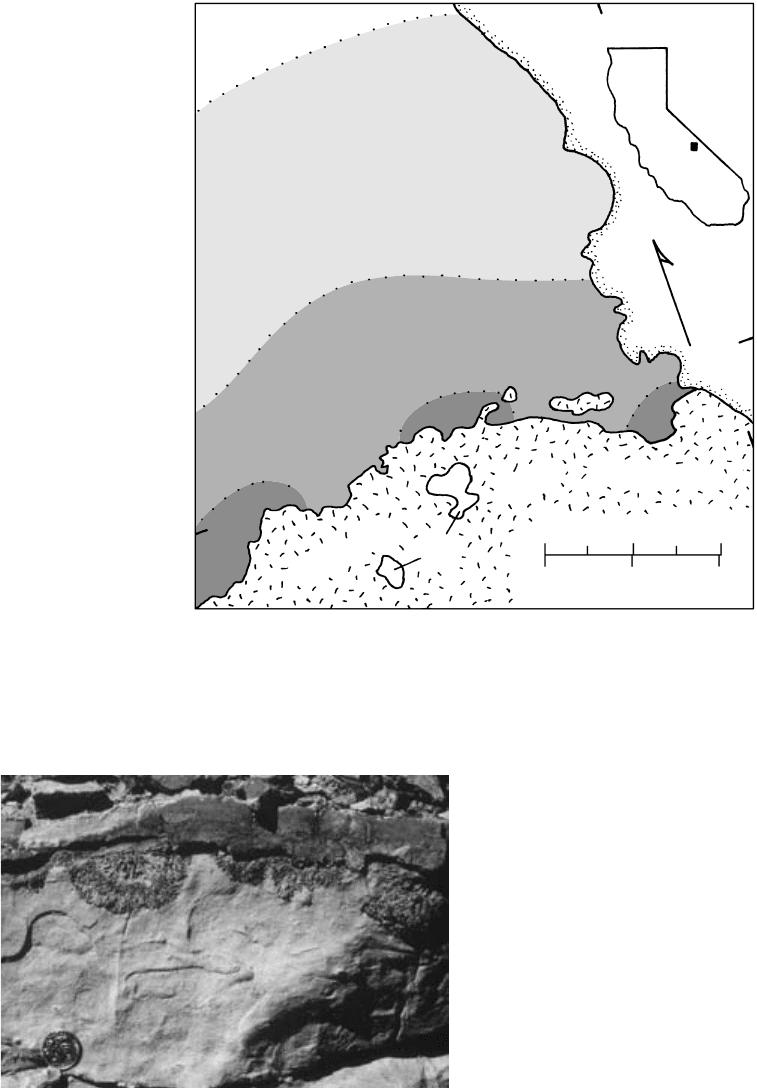
aqueous fluids that flushed out liberated CO
2
so as to
maintain a sufficiently high water activity during meta-
morphism. That this is so can be appreciated from Fig-
ure 16.24, which shows relevant univariant reaction
curves and equilibria appropriate for siliceous dolo-
stones (10% quartz, 90% dolomite). In an open system
at 1 kbar flooded by water-rich fluid (X 0.1), dis-
continuous prograde reactions produce tremolite near
415°C, forsterite at about 470°C, and periclase near
640°C. These temperatures compare favorably with
calcite–dolomite solvus thermometry in the hornfelses
determined by Roselle et al. (1997): 475°C in the upper
tremolite zone, 475–500°C in the lower to middle
forsterite zone, and 620°C at the periclase-in isograd.
The irregularity of the periclase isograd and layer-
specific metamorphism in the Ubehebe aureole suggest
heterogeneous infiltration of fluids. O- and C-isotope
ratios strongly support nonuniform infiltration of mag-
matic fluids and confirm their water-rich composition,
X 0.3 (Roselle et al., 1999).
16.7.2 Mechanics of Fluid Flow
In order for fluid to move through solid rock there must
be both openings (porosity) that are interconnected so
CO
2
CO
2
500 Igneous and Metamorphic Petrology
Ubehebe
Pz
Peak
0 km 0.8
0 miles 0.5
Intrusion
36°
42′
30″
117°35′
Tremolite zone
Alluvium
N
U
n
m
e
t
a
m
o
r
p
h
o
s
e
d
C
a
l
i
f
o
r
n
i
a
Periclase
Zone
F
o
r
s
t
e
r
i
t
e
z
o
n
e
16.21 Ubehebe Peak contact metamorphic aureole in siliceous dolostones, Death Valley National Monument, California. In contrast to the
broad tremolite and forsterite zones, the periclase zone (darkest shade) is thin and impersistent adjacent to the granitic intrusion.
Quaternary alluvium (Qa) enclosed by dotted line. Inset in upper right shows location of Death Valley National Park in the state of
California. Pz, Paleozoic rocks. Redrawn from Roselle et al. (1999).
16.22 “Blossoms” of tremolite grown below a quartzite layer into
dolomarble, Ubehebe Peak contact aureole, Death Valley
National Monument, California (Baumgartner et al., 1997).
Tremolite growth was positioned along cracks where advect-
ing aqueous fluids infiltrated into the rock and is believed to
have formed by the reaction (see Figure 16.24) 5 dolomite
8 quartz H
2
O tremolite 3 calcite 7CO
2
. Coin is
24 mm in diameter. Photograph courtesy of Gregory
T. Roselle.
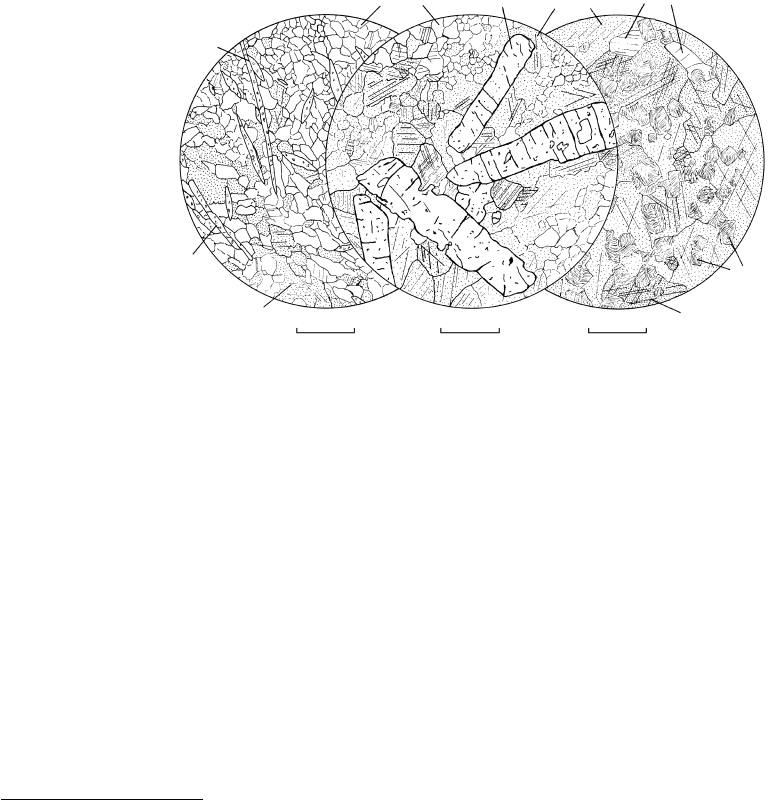
as to allow transfer of the fluid (permeability), and a
driving force to propel the fluid.
Porosity and Permeability. Other than widespread frac-
tures that were mostly produced during uplift and
stress relief, metamorphic rocks exposed at the surface
of the Earth possess only a trivial porosity, generally a
few tenths of 1% by volume. Because most openings in
the rock existing during its metamorphism deep in the
crust have vanished, careful observations of rock fabric
combined with laboratory investigations simulating
metamorphic conditions are necessary to determine the
origin and nature of porosity and permeability during
metamorphism (Brenan, 1991).
Openings can be inherited from the protolith—such
as pore spaces between clasts and vesicles in volcanic
rocks—but these generally become closed by increas-
ing P during burial and by filling with mineral precipi-
tates (e.g. amygdules).
Experiments on rocks at elevated P and T indicate
the character of very small volumes of fluid that can ex-
ist along grain boundaries in metamorphic rocks. The
basic principle underlying this transient intergranular
porosity and possible permeability involves the rela-
tions between surface energies of crystalline grains and
the fluid as formulated in the dihedral angle, (Section
11.2.2 and Figure 11.7). At equilibrium, no natural
fluid–solid pair exists for which 0°, ensuring that
no fluid film can form a continuous grain-boundary
film covering the entire grain. Under some conditions,
interconnected threadlike volumes of fluid may exist
along three-grain tubular edges for 0° 60° (Hol-
ness, 1997). In pure calcite aggregates containing water,
60° at any P and T but with addition of NaCl or in
nearly equimolar H
2
O–CO
2
fluids 60° but only at
low P and probably high T. Hence, relatively pure car-
bonate rocks are generally impermeable except where
special fluids exist or where the rock is being deformed
by ductile flow or by fracturing. In silicate rocks, dis-
solved NaCl and feldspar components can reduce to
60°. In most metamorphic rocks, fluids will generally
occur in isolated “pools” at multiple grain corners
where 60°. Of course, these spatial relations do not
apply where the fluid/rock ratio may be large during
the course of an active devolatilization reaction.
An important means of creating openings in rock
undergoing metamorphism is by reaction-enhanced
permeability (Rumble et al., 1982). This phenomenon
is a consequence of the fact that the volume of solid
products is generally less than the volume of solid
reactants undergoing devolatilization. For dehydration
reactions involving silicates, V may not be very great
Metamorphic Mineral Reactions and Equilibria
501
Tremolite
Tremolite
Brucite
Calcite
Calcite
Dolomite Forsterite Calcite Dolomite
0 0.5mm 0 1mm 0
(a) TREMOLITE ZONE
5 dolomite 8 quartz H
2
O →
tremolite 3 calcite 7CO
2
(b) FORSTERITE ZONE
11 dolomite tremolite →
8 forsterite 13 calcite
9CO
2
H
2
O
(c) PERICLASE ZONE
dolomite → periclase
calcite CO
2
(Retrograde:
periclase H
2
O → brucite)
0.5mm
16.23 Contact metamorphosed siliceous dolostones from the Ubehebe Peak contact aureole, Death Valley National Monument, California.
See also Figure 16.21. Drawn from annotated photomicrographs supplied through the courtesy of Gregory T. Roselle. Possible reactions
progressively consuming (from left to right) dolomite and yielding calcite are indicated below drawings. (a) Lowest grade tremolite
( calcite) zone believed to have formed by reaction between dolomite and minor quartz that was entirely consumed but leaving excess
dolomite. Exact reaction is uncertain as there is no lower grade talc zone as expected where aqueous fluids drove the mixed-volatile fluid
reactions. (b) Forsterite zone. Large robust forsterite prisms and surrounding calcite grains were developed in the outer part of the
aureole whereas much smaller, equant anhedral forsterite grains were produced closer to the intrusion (see Figure 17.3). Note diameter
of field is twice that of other two views. (c) Brucite–calcite rock from the periclase zone immediately adjacent to the intrusion. Periclase
in contact metamorphosed carbonate rocks is almost invariably hydrated during cooling to form platy aggregates of brucite. Note sparse
excess dolomite.
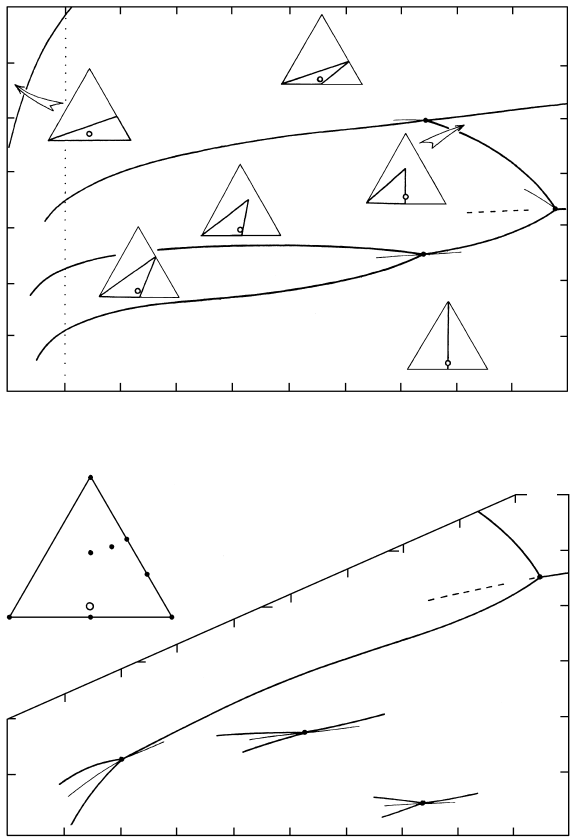
—about 3% for the reaction muscovite quartz →
sillimanite K-feldspar water. On the other hand,
V for decarbonation reactions can be much larger—
about 33% for calcite quartz → wollastonite CO
2
.
Once again, such porosities are only transient during
the course of reactions and compaction processes are
likely to expel fluids quite rapidly.
Fracturing is an obvious means of inducing open-
ings in otherwise porosity-free brittle rocks. These
cracks can either be interconnected or connect to other
types of openings, resulting in rock permeability. Obvi-
ously, channeled flow in fractures provides the most
efficient and rapid means for fluid transport. Fractures
are produced in at least three ways:
502 Igneous and Metamorphic Petrology
T (°C)
500
600
B
500
(c)
400
0.0 0.2 0.4 0.6 0.8 1.0
X
CO
2
SiO
2
Qtz
(b)
Tlc
Fo
Per
MgODol
Di
Tr
CaO
Cal
T (°C)
450
350
650
550
0.0 0.2 0.4 0.6 0.8 1.0
1.0 0.20.40.60.8 0.0
X
CO
2
X
H
2
O
(a)
2 kbar
P
fluid
5 kbar
P
fluid
1 kbar
A
1 kbar
A
A
T
r
3
C
a
l
7
C
O
2
T
l
c
3
C
a
l
3
C
O
2
D
i
2
C
O
2
D
o
l
2
Q
t
z
5
D
o
l
8
Q
t
z
H
2
O
6
D
o
l
8
Q
t
z
H
2
O
T
r
D
o
l
C
O
2
H
2
O
4
D
i
D
o
l
C
O
2
H
2
O
8
F
o
1
3
C
a
l
9
C
O
2
H
2
O
T
r
1
1
D
o
l
T
r
3
C
a
l
T
r
3
C
a
l
7
C
O
2
2
F
o
4
C
a
l
2
C
O
2
P
e
r
C
a
l
C
O
2
D
o
l
D
i
3
D
ol
5
D
o
l
8
Q
t
z
H
2
O
2
T
l
c
3
C
a
l
A
B
700
16.24 Mixed-volatile fluid equilibria in the system CaO–MgO–SiO
2
–CO
2
–H
2
O depicting possible reactions in metamorphism of siliceous
dolostones. (a) Petrogenetic grid showing univariant reaction curves at P
fluid
1 kbar. Dashed line segment on right is the metastable ex-
tension into the tremolite stability field of the univariant reaction line for dolomite 2 quartz diopside 2CO
2
that is too short where
stable to the right of invariant point B to allow labeling. Univariant reaction lines converging into the three invariant points, such as A at
420°C and X 0.72, that are thinner and unlabeled are unimportant for the purposes of this diagram (for these other
reactions see Slaughter et al., 1975). Triangles in each field indicate stably coexisting phases keyed to larger labeled triangle in (b) where
circle indicates quartz-bearing dolostone protolith. (c) Lower portion of grid from (a) but P
fluid
5 kbar to show leftward shift of
invariant point B and especially A with respect to increasing P, greatly expanding the range of fluid compositions over which tremolite
can be created as the initial product of metamorphism rather than talc. Note the invariant points have also shifted to higher T. Redrawn
from Slaughter et al. (1975) and Ferry (1991).
CO
2

1. Intercrystalline mismatches during heating as
anisotropic grains, especially quartz, expand differ-
entially in different crystallographic directions (Section
8.3.1). In effect, this is “thermal decompaction.”
2. Nonhydrostatic stresses during tectonic (orogenic)
activity that exceed the brittle strength of the rock
(Section 8.2.1).
3. Fluid overpressures surrounding magmatic intru-
sions (Section 9.1.2) and in rocks undergoing
devolatilization reactions. Metamorphic rocks typic-
ally have insufficient permeability to accommod-
ate the rate of fluid production in devolatilization
reactions. Consequently fluid pressure will build
up, exceeding the tensile brittle strength of the
rock, creating hydraulic fractures (Section 8.2.1
and Figure 8.2). In pioneering experiments, Rayleigh
and Paterson (1965) found that the strength of ser-
pentinite dropped by almost an order of magnitude
with increasing T as it partially dehydrated at
500–600°C to olivine talc, releasing several wt.%
water. Rather than becoming more ductile, as occurs
during heating of volatile-free rocks, the weakened
serpentinite was embrittled and lost cohesion as the
released water collected into hydraulically created
openings.
On a grain scale, fractures are preserved as healed
microcracks, or planar secondary fluid inclusions, that
appear as either single entities or as trains of many in-
line parallel inclusions that were filled with fluid before
being pinched off by recrystallization (Figure 16.25).
Larger scale fractures filled with minerals precipitated
from flowing fluids are manifest by veins whose thick-
nesses are measured in centimeters or meters and
lengths in meters to hundreds of meters (Figure 15.23).
Crack-seal veins reveal multiple episodes of fluid
filling, precipitation of dissolved solids, renewed crack-
ing, filling, and so on.
Because prograde devolatilization reactions occur at
distinct P–T conditions during metamorphism, related
porosity and permeability production and enhance-
ment will be episodic and transient. Devolatilization
can enhance fluid flow and fluid infiltration can induce
devolatilization reactions. Thus, these can be mutually
reinforcing or interactive feedback processes. Once
the rocks have passed through their peak thermal con-
dition and have experienced irreversible fluid loss,
further hydraulically induced fracturing will commonly
not occur, effectively sealing the rocks to any sub-
sequent fluid infiltration. Consequently, the peak meta-
morphic imprint is preserved as T falls because of the
lack of fluids to accomplish retrograde volatilization re-
actions.
Porosity and permeability production are also likely
to be spatially heterogeneous because of the hetero-
geneity of rocks in metamorphic terranes and the
episodic nature of reaction-enhanced permeability in
both space and time.
Driving Force for Fluid Flow. The flow of any liquid
through a solid material possessing interconnected
openings can be quantified by Darcy’s Law. For flow in
one dimension (the direction x) this is
16.26 V
D
where is the viscosity, about 10
4
Pa s for H
2
O–CO
2
fluids in most metamorphic systems, according to
Walther and Orville (1982). V
D
is the volumetric flux,
or volume of flow per unit time per unit area of mater-
ial traversed; it has units of m
3
/m
2
s m/s and is,
therefore, justifiably called the Darcy velocity. The
actual velocity of the liquid through small grain-scale
openings in rocks is much greater. The permeability,
k, has units of m
2
and ranges over many orders of
magnitude in rocks, but at depths of more than about
12 km is apparently close to 10
18
m
2
(Ingebritsen and
Manning, 1999) where no devolatilization reactions are
actively going on.
The dP/dx term in Darcy’s Law is the pressure gra-
dient that drives the flow. In many metamorphic sys-
tems, this gradient arises from a thermal gradient that
causes uneven expansion of a fluid, imparting buoy-
ancy. For geothermal gradients 20°C/km the density
of water decreases with depth (Figure 4.3) so it be-
comes more buoyant, driving water upwards through
permeable rock in the crust. However, fluid flow in the
¢
k
≤¢
dP
dx
≤
Metamorphic Mineral Reactions and Equilibria
503
16.25 Healed microcracks (secondary fluid inclusions) in quartz,
Proterozoic Wolf River Batholith, Wisconsin. At least two sub-
parallel sets of cracks are evident at an angle of about 60° to
one another. Photomicrograph courtesy of Bart J. Kowallis.
continental crust is not everywhere vertically upward
because a large component of geothermal water and
advecting water around shallow magmatic intrusions is
meteoric. Moreover, the pattern of fluid infiltration in
some contact metamorphic aureoles indicates subhor-
izontal channelized flow in highly permeable layers.
Fluid flow can be focused in fault zones where a
different sort of pressure gradient is produced by dila-
tancy pumping. As stress builds up immediately prior
to faulting, rocks experience a perceptible increase in
volume (dilatancy) as a result of pervasive microcrack-
ing. The opening cracks are local sites of reduced pres-
sure and consequently suck any nearby fluid into them.
But once failure occurs, stress is released, microcracks
collapse, and fluid is driven out. This pumping action
and other possible mechanisms may cause fluid flow in
ductile shear zones (marked by mylonite) as well as
more brittle faults (Ord and Oliver, 1997).
It is entirely possible that fluid flow would be
limited in metamorphic rocks without the effects of
reaction- and deformation-enhanced permeability.
16.8 METASOMATISM
Most metamorphic reactions involve movement of
ions on the scale of consuming reactant and growing
product grains. However, the foregoing pages have
demonstrated that large-scale fluid movement occurs
in metamorphic terranes. In most instances, these
infiltrating fluids are likely to react to some degree with
the rocks through which they flow. The term meta-
somatism is conventionally applied where the distance
between the source and sink of the transported mater-
ial is more than the scale of individual grains and there
is a significant change in the bulk chemical and modal
composition of the protolith. (Compare cryptic meta-
somatism in mantle rocks, Section 11.2.2.) Metasomat-
ism has been placed in a thermodynamic context since
the middle twentieth century by J. B. Brady, G. W.
Fisher, D. S. Korzhinskii, J. B. Thompson, and others.
For reviews see Barton et al. (1991) and Winter (2001,
Chapter 30).
Metasomatism can be driven by differences in
chemical potential between adjacent compositionally
contrasting rock volumes and accomplished by diffu-
sion at relatively high T over prolonged periods of
time. An example is the so-called bimetasomatism at
contacts between silicate and carbonate-bearing rock
where, to a first approximation, Si has moved from the
former into the latter and Ca in the opposite direction.
Most metasomatism, however, is related to infiltration
of fluids into highly permeable rocks. This is especially
common in, but by no means restricted to, contact
metamorphic aureoles and oceanic ridges.
Interpretations of metasomatic rocks generally must
deal with three unknowns: the character of the protolith,
the gains and losses of elements (what chemical
species were mobile versus immobile, and which were
conserved), and the metasomatic process (whether
constant volume or not). Without some independent
information, the composition of the metasomatic rock
alone cannot provide answers to all of these unknowns.
It is commonly assumed that certain chemical con-
stituents remained immobile during metasomatism,
such as Al
2
O
3
, TiO
2
, and high-field-strength trace
elements (Figure 2.20), but this assumption can be a
pitfall unless tested and evaluated in some way. Field
relations and rock fabric can provide constraints in
some cases, as in resolving the long-standing dilemma
regarding serpentinization of ultramafic rocks (Section
15.2.7). In contact metamorphic aureoles, unlike re-
gional terranes, distinct rock layers can often be traced
along their strike from unaltered protoliths a kilometer
or less from the intrusion into metasomatized rocks
nearer the magmatic contact.
Some petrologists have argued for removal of as
much as 20 wt.% of the total nonvolatile mass of pelitic
rocks during Barrovian regional metamorphism. How-
ever, most believe that less than 3 wt.% of nonvolatiles
are lost and, to a first approximation, metamorphism
is isochemical in terms of nonvolatile elements but
metasomatic in terms of perfectly mobile volatiles. In
this controversy, it is difficult to accurately evaluate the
amount of mass transferred out of a regional terrane
because of the heterogeneity of the protoliths and their
uncertain initial chemical compositions (Walther et al.,
1995; Vernon, 1998). Another impediment is how to
devise a rigorous sampling plan that can accurately and
reliably test the amount of transfer.
16.8.1 Ion Exchange Reactions in Open
Metasomatic Systems
Most rock-forming silicate minerals and their chemical
components are only very slightly soluble in H
2
O–CO
2
fluids; thus, very large volumes are required to trans-
port significant masses of dissolved silicates, as dis-
cussed above for quartz. Solubilities depend on the
composition of the fluid, P, and T (Labotka, 1991).
Greater Cl concentrations in aqueous fluids can pro-
mote greater solubilities, especially for alkalies (Na,
K, Rb). Salts of Cl
, SO
4
2
, and CO
2
3
, such as KCl,
CaSO
4
, and Na
2
CO
3
, have significantly greater solubil-
ities in aqueous fluids than silicates and consequently
greater amounts of these materials can be transported
by fluid flow. As carbonates, halides, and sulfates are
the very materials generally found in fluid inclusions in
metamorphic minerals (Special Interest Box 16.3), they
are likely to have been involved in the solid–fluid reac-
tions occurring during metamorphism.
Mineral components can have a source in the rocks
through which fluids percolate, dissolving or leaching
out the more soluble, mobile components. Or the
504 Igneous and Metamorphic Petrology
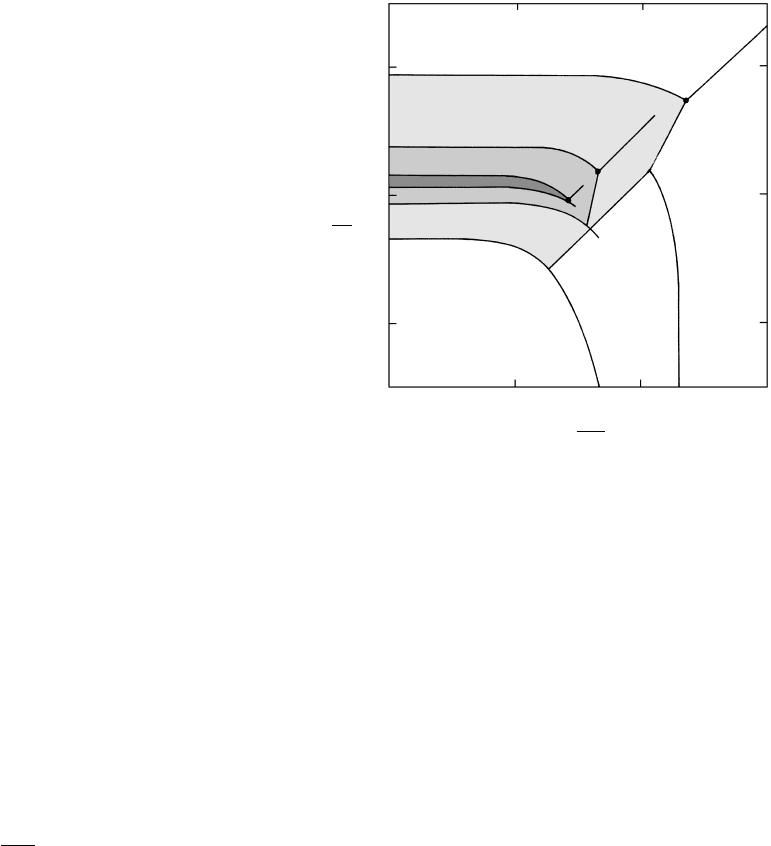
components may have been derived from nearby mag-
matic sources, such as silica in the metasomatizing
solutions at Crestmore, California (Section 14.2.5).
In an ion-exchange reaction, ions in a fluid ex-
change with other ions in neighboring solids without
destroying them. This reaction is modeled as follows:
16.27 AX B
BX A
solid in fluid solid in fluid
A familiar example of an ion-exchange reaction is the
water-softening action of some Na-bearing zeolites in
which dissolved Ca
2
, which causes “hardness” in
water, is taken into the zeolite in exchange for two
Na
, which pass from the zeolite into the water.
Common alkali-ion-exchange reactions in metamor-
phic rocks involve micas and feldspars as these are the
chief repositories of Na and K. Many different reac-
tions can be written but for muscovite breakdown two
possibilities include:
16.28 KAl
2
AlSi
3
O
10
(OH)
2
6SiO
2
2K
muscovite quartz in fluid
3KAlSi
3
O
8
2H
K-feldspar in fluid
16.29 2KAl
2
AlSi
3
O
10
(OH)
2
2H
muscovite in fluid
3Al
2
SiO
5
3SiO
2
3H
2
O 2K
quartz in fluid solution
For reaction 16.29 where the solid phases and water are
pure with activities 1 the equilibrium constant, K
eq
, is
16.30 K
eq
showing that the stabilities of micas and alkali feldspars
in aqueous solutions depend on ratios of activities at a
specified P and T (Figure 16.26). High H
concentra-
tions relative to K
and Na
stabilize an aluminosilic-
ate, whereas the opposite stabilize feldspars. Micas are
stable at intermediate alkali ion/hydrogen ion ratios.
Hydrogen metasomatism is particularly common
and widespread around granitic intrusions in the shal-
low continental crust. The high H
activity relative to
other major elements causes removal of Na, K, Ca, Mg,
and Fe in feldspars and mafic silicates in felsic country
rocks as well as the intrusion. In the initial sericitic
alteration stage, white micas clay minerals are stabil-
ized at the expense of feldspars. Clay minerals, such as
kaolinite, are stabilized at the expense of K-feldspar
according to the reaction
16.31 2KAlSi
3
O
8
2H
H
2
O
Al
2
Si
2
O
5
(OH)
4
4SiO
2
2K
a
K
2
a
H
2
More aluminous chlorites and epidotes replace biotite,
amphibole, and pyroxene. In more advanced argillic
alteration, feldspars and micas are converted into
pyrophyllite, andalusite, and other aluminosilicates.
Where the activity of S is sufficient, Fe from break-
down of mafic silicates and Fe–Ti oxides produces
widespread pyrite. At higher T, greisens may develop
(Section 15.2.8) that contain aluminosilicates such as
topaz (high F activity) and tourmaline (B). Extensive
halos of sericitic and argillic alteration around more
localized hydrothermal ore deposits provide valuable
exploration targets.
16.8.2 The Thompson Model of Metasomatic Zoning
and Local Equilibrium
For a system to be in complete thermodynamic equi-
librium, all intensive variables—T, P, and chemical
potentials of every component—must be uniform
throughout. No incompatible phases, such as quartz
and forsterite, can exist together. However, as Thomp-
son (1959, p. 430) points out, “though a large volume
of rock commonly contains mutually incompatible
phases and is thus not in internal equilibrium, it is
generally possible to regard any part of such a thermo-
dynamic system as substantially in internal equilibrium
if that part is made sufficiently small.” This expression
of the concept of local equilibrium has a significant
Metamorphic Mineral Reactions and Equilibria
505
10
2
10
1
10
3
10
4
10
3
Paragonite
600°C
500°C
650°C
Muscovite
K-feldspar
Albite
Ms
Ab
Kfs
Ab
Ms
Pg
Ms
Al
2
SiO
5
Qtz
10
2
10
1
Na
H
Al
2
SiO
5
K
H
16.26 Phase relations in the system Na–K–Al–Si–O–H as a function
of T and the ratios of alkali and hydrogen ions at 5 kbar and
a 0.5. Ion-exchange reactions 16.28 and 16.29 are top
and bottom subhorizontal lines, respectively. Note shrinking
of muscovite stability field with increasing T (light shaded at
500°C, medium shaded at 600°C, and dark shaded at 650°C)
and absence of paragonite field at 600 and 650°C. Compare
Figure 14.31. Redrawn from Wintsch (1975).
H
2
O
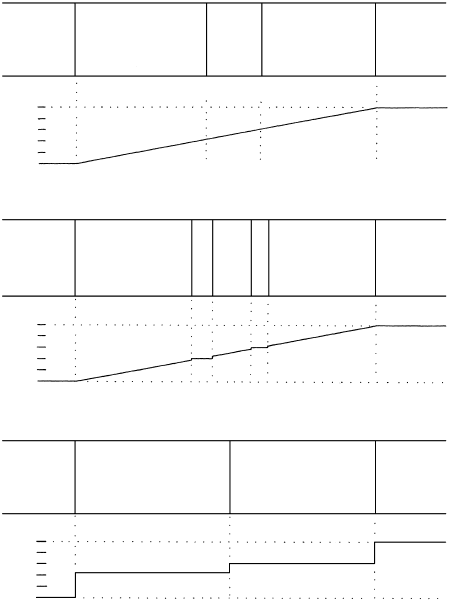
bearing on the fate of juxtaposed local systems that
equilibrate via diffusion-controlled reactions to pro-
duce sharply bounded mineral layers of a small number
of phases. Juxtaposed incompatible systems include
vein solutions markedly out of equilibrium with wall-
rock mineral assemblages and bedded carbonate and
silicate rocks deposited in a sedimentary environment
that are unstable under metamorphic conditions.
To illustrate the concept of local equilibrium,
Thompson (1959) used a hypothetical example at fixed
P and T in which a region of pure periclase is separated
from a region of pure quartz by three two-phase zones
in which the bulk composition varies continuously and
linearly (Figure 16.27, top). Across each of these two-
phase zones, such as periclase forsterite, the modal
proportions of each phase varies inversely and con-
tinuously so that the variation in bulk composition is
continuous. Within each zone, as well as in the two
end regions, local equilibrium prevails. Each of the
two-phase assemblages is stable and no reaction should
occur within them. However, along zone boundary F, a
few grains of periclase in the left zone are in contact
with enstatite grains in the right zone. As this pair of
phases is less stable than forsterite, an intermediate
one-phase zone of that mineral may form, resulting in
a local reduction of the number of phases. Similarly,
a zone of pure enstatite may form in place of the
interface E. The extent to which these monomineralic
forsterite and enstatite zones replace the neighbor-
ing two-phase zones would depend upon the available
time for the diffusion of Si and Mg. Ultimately, the
diffusion process might produce the stepped chemical
configuration of Figure 16.27, bottom, in which only
monomineralic forsterite and enstatite zones occur
between the periclase and quartz regions. Four areas of
local one-phase equilibrium now exist.
A natural example of local equilibrium in a diffusion-
controlled metasomatic system is the reaction at the
interface between nodules of chert (microcrystalline
quartz) and host dolostone protolith. In this case, how-
ever, the system is not binary and reaction layers need
not be monomineralic. Joesten (1991) has provided
a detailed thermodynamic analysis of the chemical
potential gradients that drive diffusional exchange
of CaO, MgO, and SiO
2
across the incompatible
dolomite–quartz contact. Depending on the P–T con-
ditions, buffering mineral reactions, and diffusion
coefficients different types of layers and layer thick-
nesses develop (Figure 16.28).
16.8.3 Low-Variance Assemblages
in Metasomatic Rocks
Because metasomatism is accomplished by infiltration
of relatively large amounts of fluid, at least it and one
or more dissolved components will be perfectly mobile
in the sense defined in Section 16.6.3. Inasmuch as
perfectly mobile components are not counted in the
phase rule, the variance of the system is less than if the
components were not mobile. The mineralogical phase
rule derived in Section 15.3.1, C , can be rewritten
as C C
m
for metasomatic systems, where C
m
is
the number of mobile components. Consequently, a
typical property of metasomatic mineral assemblages
is the relatively small number of solid phases, because
the number of components is small. Theoretically, all
of the components in a metasomatic system could be
mobile but that would mean that there would be no
phases (C C
m
0 ), which is impossible. So
at least one component must be immobile in a one-
phase assemblage; monomineralic assemblages tend
to be common in, for example, fluid-dominated vein
systems.
16.8.4 Frames of Reference and the Isocon Diagram
If so many components are on the move in metaso-
matic systems, how is the petrologist to decide which
were actually mobile? Careful petrographic study can
help, as can examination of field relations, especially
between the altered rock and what may be the protolith,
across isograds and other metasomatic transitions (for
example, Figure 16.28). With the proper frame of
reference, chemical changes might be ascertained. But
506 Igneous and Metamorphic Petrology
Periclase Forsterite Enstatite Quartz
Periclase
Forsterite
Enstatite
Periclase
forsterite
Fo
En
Enstatite
quartz
Quartz
Periclase
100
0
wt. %
SiO
2
Periclase
forsterite
F
Fo
En
Enstatite
quartz
Quartz
E
16.27 Hypothetical model of metasomatic zoning in system where
local equilibrium prevails. Redrawn from Thompson (1959).
